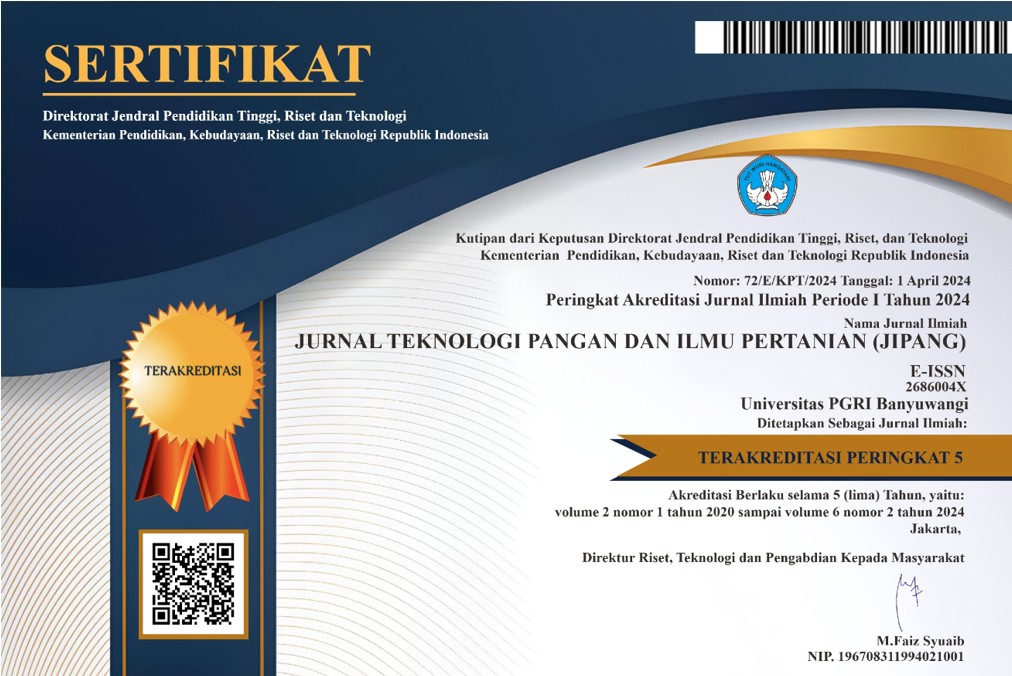PENGUJIAN UMUR SIMPAN GETUK TINGGI PROTEIN CITARASA REMPAH
Shelf Life Testing Getuk High Protein Spice Flavor
Keywords:
getuk, mung beans, shelf-life, spiceAbstract
This study aims to extend the shelf life of getuk by adding mung beans, then diversify the taste of the product by adding ginger or cinnamon essential oil. In the first stage of making high protein getuk, there are three formulas, namely original getuk (GO), ginger flavored getuk (GJ), cinnamon flavored getuk (GK). The next step is to determine the shelf life of spice-flavoured high-protein getuk stored at room temperature of 25°C in a desiccator to avoid contamination and in a refrigerator at a temperature of 5°C for 7 consecutive days. Observations were made on the total number of microbes using the TPC (total plate count) method with the medium used was Plate Count Agar (PCA). Storage using a refrigerator at a temperature of 5°C and room temperature of 25°C in a desiccator on days 0, 1, and 2 the total number of bacteria that grew below 104 for all high-protein getuk formulas, but on day 3 the total number of bacteria already above the maximum value allowed by BPOM in 2019. Similar to room temperature storage, spice-flavoured high-protein getuk cannot extend shelf life but can reduce the total number of microbes in each sample.
References
BPOM (Badan Pengawas Obat dan Makanan). 2019. Pedoman Penerapan Peraturan nomor 13 Badan POM Tentang Cemaran Mikroba Dalam Pangan Olahan. Jakarta: Direktorat SPP, Deputi III, Badan POM RI ISBN 978-602- 3665-11
Durak A., Gawlik-Dziki U., Pecio Ł. 2014. Coffee with cinnamon - Impact of phytochemicals interactions on antioxidant and anti-inflammatory in vitro activity. Journal Food Chemistry. 162:8188.doi:10.1016/j.foodchem.2014.03.13.
El-baky H.H.A., Farag R.S., Saleh M. 2010. Characterization of antioxidant and antimicrobial compounds of cinnamon and ginger essential oils. African Journal Biochemistry Research. 4(6):167–174.
Falade K.O., Akingbala J.O. 2011. Utilization of Cassava for food. Food Rev. Int. 27(1):5183.doi:10.1080/87559129.2010.518296.
Haggblade S., Djurfeldt A.A., Nyirenda D.B., Lodin J.B., Brimer L., Chiona M., Chitundu M., Chiwona-Karltun L., Cuambe C, Dolislager M, et al. 2012. Cassava commercialization in Southeastern Africa. Journal Agribussines. Dev. Emerg. Econ. 2(1):4–40.doi:10.1108/20440831211219219.
Hasan H. 2012. Chemical composition and antimicrobial activity of the crude extracts isolated from zingiber officinale by different solvents. Pharm. Anal. Acta. 03(09).doi:10.4172/2153-2435.1000184.
Issouffou C, Suwansri S., Salaipeth L., Domig K.J., Hwanhlem N. 2018. Synergistic effect of essential oils and enterocin KT2W2G on the growth of spoilage microorganisms isolated from spoiled banana peel. Journal Food Control. 89:260269.doi:10.1016/j.foodcont.2018.02.019
Khaledian Y, Pajohi-Alamoti M, Bazargani-Gilani B. 2019. Development of cellulose nanofibers coating incorporated with ginger essential oil and citric acid to extend the shelf life of ready-to-cook barbecue chicken. Journal Food Process. Preserv. 43(10):1–13.doi:10.1111/jfpp.14114.
Lin C.W., Yu C.W., Wu SC., Yih KH. 2009. DPPH free-radical scavenging activity, total phenolic contents and chemical composition analysis of forty-two kinds of essential oils. Journal Food Drug Anal. 17(5):386395.doi:10.38212/2224-6614.2594.
Mesomo M.C., Corazza M.L., Ndiaye P.M., Dalla Santa O.R., Cardozo L., Scheer A.D.P. 2013. Supercritical CO2 extracts and essential oil of ginger (Zingiber officinale R.): Chemical composition and antibacterial activity. Journal Supercrit.Fluids.80:44.49.doi:10.1016/j.supflu.2013.03.031.
Mortazavi N., Aliakbarlu J. 2019. Antibacterial Effects of Ultrasound, Cinnamon Essential Oil, and Their Combination Against Listeria monocytogenes and Salmonella Typhimurium in Milk. Journal Food Science.84(12):37003706.doi:10.1111/1750-3841.14914.
Noori S., Zeynali F., Almasi H. 2018. Antimicrobial and antioxidant efficiency of nanoemulsion-based edible coating containing ginger (Zingiber officinale) essential oil and its effect on safety and quality attributes of chicken breast fillets. Journal Food Control. 84:312–320.doi:10.1016/j.foodcont.2017.08.015
Okogbenin E, Setter TL, Ferguson M, Mutegi R, Ceballos H, Olasanmi B, Fregene M. 2013. Phenotypic approaches to drought in cassava: Review. Front. Physiol. 4 MAY(May):116.doi:10.3389/fphys.2013.00093.
Prasetyaningrum, Utami R, R. Baskara K.A. 2012. Aktivitas Antioksidan, Total Fenol, dan Antibakteri Minyak Atsiri dan Oleoresin Kayu Manis (Cinnamomum burmannii). Jurnal Teknosains Pangan. 1(1):2302–0733.
Proença C, Freitas M, Ribeiro D, Oliveira EFT, Sousa JLC, Tomé SM, Ramos MJ, Silva AMS, Fernandes PA, Fernandes E. 2017. α-Glucosidase inhibition by flavonoids: an in vitro and in silico structure–activity relationship study. Journal Enzyme Inhib. Med. Chem. 32(1):12161228.doi:10.1080/14756366.2017.1368503.
Susanti T.M.I., Panunggal B. 2015. Analisis Antioksidan, Total Fenol Dan Kadar Kolesterol Pada Kuning Telur Asin Dengan Penambahan Ekstrak Jahe. Journal Nutritional Coll. 4(4):636–644.doi:10.14710/jnc.v4i4.10173.
Tohma H, Gülçin İ, Bursal E, Gören AC, Alwasel SH, Köksal E. 2017. Antioxidant activity and phenolic compounds of ginger (Zingiber officinale Rosc.) determined by HPLC-MS/MS. J. Food Meas. Charact. 11(2):556–566.doi:10.1007/s11694-016-9423-z.
Uchechukwu-Agua AD, Caleb OJ, Opara UL. 2015. Postharvest Handling and Storage of Fresh Cassava Root and Products: a Review. Food Bioprocess Technol. 8(4):729–748.doi:10.1007/s11947-015-1478-z.











